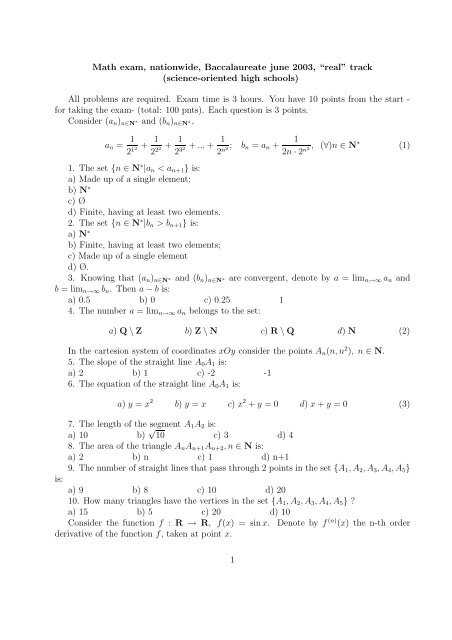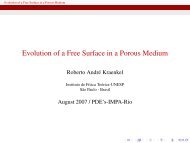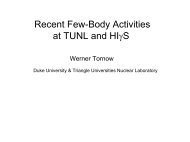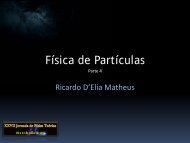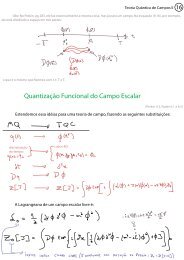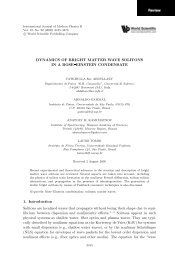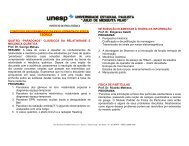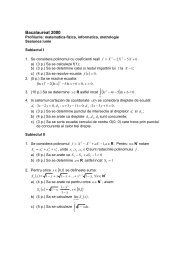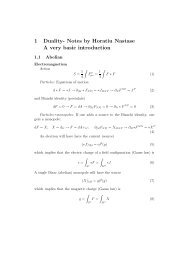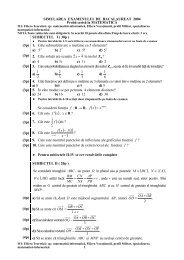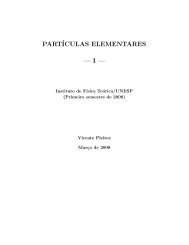Bac math exam 2003
Bac math exam 2003
Bac math exam 2003
Create successful ePaper yourself
Turn your PDF publications into a flip-book with our unique Google optimized e-Paper software.
Math <strong>exam</strong>, nationwide, <strong>Bac</strong>calaureate june <strong>2003</strong>, “real” track<br />
(science-oriented high schools)<br />
All problems are required. Exam time is 3 hours. You have 10 points from the start -<br />
for taking the <strong>exam</strong>- (total: 100 pnts). Each question is 3 points.<br />
Consider (a n ) n∈N ∗ and (b n ) n∈N ∗,<br />
a n = 1 + 1 + 1 + ... + 1<br />
1<br />
; b n = a n + , (∀)n ∈ N ∗ (1)<br />
2 12 2 22 2 32 2 n2 2n · 2 n2<br />
1. The set {n ∈ N ∗ |a n < a n+1 } is:<br />
a) Made up of a single element;<br />
b) N ∗<br />
c) Ø<br />
d) Finite, having at least two elements.<br />
2. The set {n ∈ N ∗ |b n > b n+1 } is:<br />
a) N ∗<br />
b) Finite, having at least two elements;<br />
c) Made up of a single element<br />
d) Ø.<br />
3. Knowing that (a n ) n∈N ∗ and (b n ) n∈N ∗ are convergent, denote by a = lim n→∞ a n and<br />
b = lim n→∞ b n . Then a − b is:<br />
a) 0.5 b) 0 c) 0.25 1<br />
4. The number a = lim n→∞ a n belongs to the set:<br />
is:<br />
a) Q \ Z b) Z \ N c) R \ Q d) N (2)<br />
In the cartesion system of coordinates xOy consider the points A n (n, n 2 ), n ∈ N.<br />
5. The slope of the straight line A 0 A 1 is:<br />
a) 2 b) 1 c) -2 -1<br />
6. The equation of the straight line A 0 A 1 is:<br />
a) y = x 2 b) y = x c) x 2 + y = 0 d) x + y = 0 (3)<br />
7. The length of the segment A 1 A 2 is:<br />
a) 10 b) √ 10 c) 3 d) 4<br />
8. The area of the triangle A n A n+1 A n+2 , n ∈ N is:<br />
a) 2 b) n c) 1 d) n+1<br />
9. The number of straight lines that pass through 2 points in the set {A 1 , A 2 , A 3 , A 4 , A 5 }<br />
a) 9 b) 8 c) 10 d) 20<br />
10. How many triangles have the vertices in the set {A 1 , A 2 , A 3 , A 4 , A 5 } ?<br />
a) 15 b) 5 c) 20 d) 10<br />
Consider the function f : R → R, f(x) = sin x. Denote by f (n) (x) the n-th order<br />
derivative of the function f, taken at point x.<br />
1
11. Which of the following numbers is the period of the function f?<br />
a) π b) π/2 c) 2π d) 3π (4)<br />
12. How many points of local maximum does the function f have in the interval [0, 11π]?<br />
a) 11 b) 5 c) 6 10<br />
13. The area of the plane surface between the graph of the function f, the Ox axis and<br />
the straight lines of equations x = 0 and x = 2π is:<br />
a) 0 b) 2 c) 4 d) 3<br />
14. The value of<br />
lim<br />
x→∞<br />
∫ x<br />
0 |f(t)|dt<br />
x<br />
is:<br />
a) 0 b) 2 c)1 d) ∞ (6)<br />
π<br />
15. The maximum length of an interval included in [0, 2π] on which the function f is<br />
convex, is:<br />
a) π 2<br />
b) π c) 2π d) 3π 2<br />
(7)<br />
16. The value f (2004) (0) is:<br />
a) 1 b) -1 c) 0 d) 0.5<br />
Consider the polynomial f = x 4 − 14x 2 + 9, with roots x 1 , x 2 , x 3 , x 4 ∈ C, the number<br />
a = √ 2 + √ 5 and the sets A = {g(a)|g ∈ Z[X]}, B = {g(a)|g ∈ Z[X], rank(g) ≤ 3}.<br />
17. Which of the following numbers is not a root of the polynomial f?<br />
a) − √ 2 + √ 5 b) √ 2 + √ 5 c) √ 2 − √ 5 d) √ 2 + √ 3 (8)<br />
18. The sum x 1 + x 2 + x 3 + x 4 equals:<br />
a) 4 b) 14 c) 0 d) -14<br />
19. The product x 1 x 2 x 3 x 4 equals:<br />
a) 0 b) 14 c) -9 d) 9<br />
20. If p √ 2 + q √ 5 + r √ 10 + s = 0, p, q, r, s ∈ Q, then the value of the expression<br />
2p + 5p + 10r + s equals:<br />
a) 0 b) 5 c) 7 d) 2<br />
21. The set A \ B is:<br />
a) Ø<br />
b) Infinite;<br />
c) Finite, having at least two elements;<br />
d) Made up of a single element<br />
Consider the matrices<br />
⎛ ⎞<br />
⎛ ⎞<br />
1 1 1 1<br />
1 0 0<br />
A ∈ M 3,4 (C), A = ⎝0 1 1 1⎠ and I 3 = ⎝0 1 0⎠ (9)<br />
0 0 1 1<br />
0 0 1<br />
22. The rank of matrix A is:<br />
2<br />
(5)
a) 4 b) 1 c) 3 d) 2<br />
23. The solution of the system of equations<br />
x + y + z + t = 1<br />
y + z + t = 0<br />
z + t = 0 (10)<br />
where (x, y, z, t) ∈ C 4 , is:<br />
a) (-1,1,-1,1) b) (1,1,-1,-1) c) (1, 0, λ, −λ), λ ∈ C d) (1,-1,1,-1)<br />
24. The equation AX = I 3 , X ∈ M 3,4 (C) has<br />
a) No solutions;<br />
b) An infinity of solutions;<br />
c) A single solutions;<br />
d) An infinite number of solutions strictly larger than 1.<br />
25. The matrix I 3 A has the sum of its elements equal to:<br />
a) 9 b) 10 c) 0 d) 12<br />
26. The set {Y ∈ M 4,3 (C)|det(Y A) ≠ 0} is:<br />
a) Empty;<br />
b) Made up of a single element;<br />
c) Made up of a finite number of elements, at least 2;<br />
d) Infinite<br />
27. How many solutions has the equations ˆ3x = ˆ0 in the ring Z 6 ?<br />
a) 1 b) 4 c) 2 d) 3<br />
28. The sum ˆ1 + ˆ2 + ˆ3 + ˆ4 + ˆ5, calculated in the ring Z 6 , is:<br />
a) ˆ3 b) ˆ2 c) ˆ0 d) ˆ1<br />
29. The product ˆ1 · ˆ2 · ˆ3 · ˆ4 · ˆ5, calculated in the ring Z 6 , is:<br />
a) ˆ1 b) ˆ2 c) ˆ3 d) ˆ0<br />
30. What is the order of the element ˆ2 in the group (Z 6 , +)?<br />
a) 2 b) 4 c) 6 d) 3<br />
3


